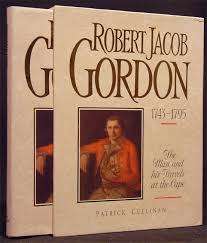
Robert Jacob Gordon 1743-1795 THE MAN AND HIS TRAVELS IN THE CAPE Patrick Cullinan First Edition
Check my rate
| Main centres: | 1-3 business days |
| Regional areas: | 3-4 business days |
| Remote areas: | 3-5 business days |

| Main centres: | 1-3 business days |
| Regional areas: | 3-4 business days |
| Remote areas: | 3-5 business days |
"ROBERT JACOB GORDON - 1743-1795 THE MAN AND HIS TRAVELS IN THE CAPE" PATRICK CULLINAN, HARDCOVER, COMPLETE INTACT DUSTJACKET, FIRST EDITION, 215 PAGES, NUMEROUS COLOUR AND BLACK AND WHITE ILLUSTRATIONS, 8 MAPS, IN FINE SLIPCASE, NO NAMES OR INSCRIPTIONS, IN EXCELLENT CONDITION.
A comprehensive biography of Robert Jacob Gordon, covering his journeys into the interior of South Africa, his botanical studies and travel journals.Robert Jacob Gordon remains one of the least heralded of South Africas early explorers. This is in part due to his journal not being edited and published until almost 200 years after his death, and possibly to his untimely demise by his own hand, which might have been unseemly within the mores of earlier generations. Gordons contribution to the opening up of the hinterland to the European gaze thus only became public in 1988, at a time when the Europeans were being denigrated as colonists and exploiters of Africas people and resources. In this modern post-colonial world it is no longer politically correct to look at Europeans as being important influences in Africas history and heritage. Gordons importance in Africas history, however, will not be diminished by the limitations of current history directions. His abilities to see South Africas geography, natural history and people with a clear eye, unhindered by contemporary 18th century ideas and prejudices, is all too apparent to the reader of his journal, and can be seen in his critique of the writings of Anders Spaarman (Smith 1990). The ostensible reason for Gordons journeys into the interior has never been explicitly stated. However, the long letter written to his mentor in Holland, Griffier Hendrik Fagel, in 1779 (Smith & Pheiffer 1994), gives a detailed summary of the natural history, people and possible economic value of the places he visited. All this information is in keeping with the idea that he was really making observations of a military nature that could be used to hold the Cape against possible foreign intruders.
It was during these trips that Gordons clear vision of how the climate and environment operated was formed. He is the first person to state formally of the
relationship between the south-east winds of the Cape, and rains up country. He was also able to recognize the role of humans in forming shell middens on the coast, and to ask himself about the difference between those shell accumulations, which might be human-derived, or natural, particularly those in the mountains, high above the modern coastline. Thus we see an inkling of an understanding of geology and geological processes at the same time James Huttons ideas of uniformitarianism were being formed (1785), or long before Charles Lyells Principles of Geology (1830), which had such influence on Charles Darwin while he was on the Beagle when it visited the Cape in 1836. Gordon met research scientists and philosophers when he was in Europe in 1774, before coming out to the Cape to assume his post at the Castle.
